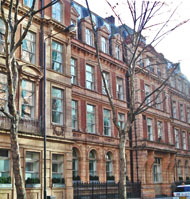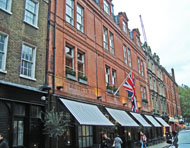Specialist
The French Hospital was opened in 1867 by Eugene Rimmel (1820-1887), a perfumer, at No. 10 Leicester Place for 'the benefit of distressed foreigners of all nations requiring medical relief'. It soon merged with the nearby French Dispensary, which had been founded in 1861 by Dr Achille Vintras (1830-1904). The establishment was then known as the French Hospital and Dispensary.
In 1878 the building was enlarged, but the premises had become inadequate. Fund-raising began for a new Hospital; generous donations were received from many ambassadors and even the French government, which gave £2,000.
A site in Shaftesbury Avenue was acquired and the foundation stone for the new Hospital and Dispensary was laid by M Waddington, the French ambassador, in July 1888. He returned to officially open it on 3rd July 1890.
The Hospital had 60 beds and had cost £22,000 to build. The wards were small - at most of 5 beds each - and spacious and airy. Curtains around the beds in the women's wards provided greater privacy than the usual screens. Nursing care was provided by the Sisters of the Order of Les Servantes du Sacre-Coeur, who had received their training at Versailles. The Sisters also looked after the laundry and the catering - two Sisters managed the kitchen, providing food for both staff and patients.
In 1896 the French Convalescent Home opened in Brighton, where patients could be sent to complete their recovery before being discharged home.
In 1910 the Hospital was enlarged; patient accommodation was
increased to 70 beds and an up-to-date operating theatre was installed.
During WW1 it became a section hospital of the First London (T.F.) General Hospital; 30 beds on the top floor wards were put at the disposal of the War Office for wounded British soldiers. Here, for the first time, they received coffee for breakfast instead of tea, and apparently appreciated it.
By 1932, as well as its 70 beds and an operating theatre, the Hospital had three consulting rooms, a dispensary, an X-ray department and a laboratory. At this time the weekly cost of keeping an in-patient was £2 7s 5d (£2.37) (compared to £2 8s 3d (£2.41) in 1931).
In 1933 a smoking room was created for the patients - an unlikely development in a hospital today. Although most of the patients were from France and its colonies, a sizable number came from Italy, Switzerland, Belgium and the United Kingdom. Presumably all were French-speaking.
Throughout the first half of the century various Presidents of the French Republic visited the Hospital, to the delight of the patients.
In 1948 the Hospital was disclaimed from the NHS, but by 1966 it was in deep financial trouble and was forced to close. The Ministry of Health bought the building in 1967 and the French Hospital became the Shaftesbury Hospital, joining the three P's group - St Peter's, St Paul's and St Philip's Hospitals - specialising in renal disease.
The Hospital, with 39 beds, closed in 1992 when the St Peter's Hospital Group was absorbed into the Middlesex Hospital.
The building is now the Covent Garden Hotel, with its entrance on Monmouth Street.


The entrance portico still bears the legend 'Hopital et Dispensaire francais'.

The back of the Hospital building in Monmouth Street states 'Nouvel Hopital et Dispensaire francais' in the brickwork.
It is the only known example of a French 19th century convalescent home and is now a Grade II listed building.
"I was a post-registration nursing students at the three P's from 1977-78 under taking a year's course in renal and urological nursing.
The top floor of the Shaftesbury Hospital at that time was split between a children's urological ward (I think sponsored by Great Ormond Street) and the School of Nursing (under Miss Callahan). The children's ward was certainly at the centre of medical research at the time, pioneering Intermittent Self-Catheterisation in children with neurogenic bladder syndrome and an out-patients clinic for children with Klinefelter's syndrome. The basement housed the British Institute of Urology (I think they had sold the Henrietta Street premises to the nursing and medical book publishers Balliere Tindall). The BIU was itself pioneering, holding multi-professional Friday lunchtime lectures which were highly successful.
The other floors were occupied by urological patients, and heart patients belonging to the Heart Foundation.
St Philip's Hospital was predominantly a renal metabolic hospital with some innovative investigative techniques.
St Peter's Hospital - mainstream urology, especially out-patients, where I learned to 'pass sounds'.
St Paul's Hospital - mainstream urology, but with acute and chronic renal units in the basement. The operating theatres were on the upper floors/attic, and still had a viewing gallery!"
Paul J. Tubbs, Head of Department: Nursing
Faculty of Health, Psychology and Social Care
Manchester Metropolitan University
(Author unstated) 1887 Obituary: Eugene Rimmel. Australian Town and Country Journal, 30th April, 926.
(Author unstated) 1890 The new French Hospital. British Medical Journal 2, 12th July, 120.
(Author unstated) 1907 Brighton French Convalescent Home and Retreat for Aged French People. British Journal of Nursing, 23rd February, 148-149.
(Author unstated) 1913 The French Hospital, Shaftesbury Avenue, W. British Journal of Nursing, 5th July, 11.
(Author unstated) 1917 List of the various hospitals treating military cases in the United Kingdom. London, H.M.S.O.
(Author unstated) 1939 Visit of the President of the French Republic and Madame Lebrun to the French Hospital. British Journal of Nursing (April), 107.
http://archive.thetablet.co.uk (1)
http://archive.thetablet.co.uk (2)
http://collage.cityoflondon.gov.uk (1)
http://collage.cityoflondon.gov.uk (2)
http://en.wikipedia.org
http://m.theargus.co.uk
http://rcnarchive.rcn.org.uk
www.ambafrance-uk.org
www.dispensairefrancais.org.uk
www.flickr.com (1)
www.flickr.com (2)
www.geograph.org
www.gilliesarchives.org.uk
www.heritage-explorer.co.uk
Return to home page